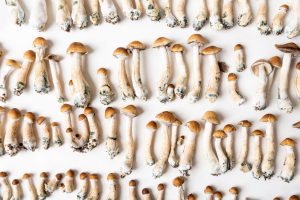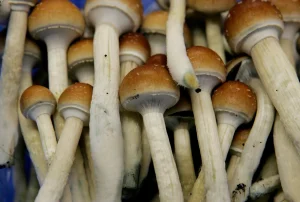Uncategorized
Psychedelic Potential: Psilocybin-Containing Mushroom Spores and Their Uses
Mushrooms, with their intricate and often enigmatic life cycles, have been a source of fascination for scientists, mycophiles, and nature enthusiasts alike. At the heart of their extraordinary lifecycle are mushroom spores, tiny reproductive units with remarkable properties. This magazine-style blog invites you to embark on a journey into the captivating realm of mushroom spores, delving deep into their unique characteristics, roles in nature, and growing interest in their potential applications.
The Magic of Mushroom Spores: A Microscopic World Unveiled

Embarking on the journey into the world of mushroom spores is akin to entering a realm of enchantment and intrigue. These tiny, often overlooked entities are the very essence of the fungal kingdom’s life cycle. Comprising just a fraction of the mushroom itself, mushroom spores possess a profound magic of their own. At first glance, they appear as minuscule, often intricate, capsules that house the genetic code for future fungal growth. However, within these microscopic packages lies a world of potential and wonder. To understand the composition and significance of mushroom spores is to grasp the fundamental processes of fungal reproduction. As they are released into the environment, they embark on a journey of their own, subject to the whims of wind, water, or various vectors that disperse them. The role of mushroom spores in the grand tapestry of life extends beyond the reproduction of fungi; it influences entire ecosystems and contributes to the interconnectedness of all living things. Their magic lies in their silent but essential role in the circle of life, awaiting the curious minds willing to unveil their mysteries.
Spores in the Wild: Dispersal and Germination
In the natural world, the process of mushroom spore dispersal and germination is nothing short of a marvel. Mushroom spores are akin to nature’s tiny, resilient travelers, designed to journey through various environments, often with the ultimate goal of initiating new fungal growth. The mechanisms by which they achieve this are nothing short of fascinating. Mushroom spores can be dispersed by a range of methods, including wind, rain, or even hitching a ride on animals. Their lightweight nature allows them to be carried by air currents, potentially covering vast distances. Rain plays a crucial role, as the impact of raindrops on mature mushroom caps forces spores to be shot into the air, giving them a chance to be carried elsewhere. Some mushrooms rely on animals, such as insects or mammals, to disperse their spores, often by attaching them to the animals’ bodies. Once in a new environment, spores face the challenge of germination, a process involving the activation of fungal mycelium growth. Successful germination is the gateway to new fungal life, and it is guided by factors like moisture, temperature, and the availability of a suitable substrate. Understanding the captivating journey of mushroom spores from dispersal to germination sheds light on their adaptability and their remarkable role in the natural world.
Beyond the Forest Floor: How Mushroom Spores Affect Ecosystems

Mushroom spores are not only fascinating on a microscopic level but also play a significant role in shaping entire ecosystems. When we delve into the broader ecological impact of these spores, we begin to uncover a web of intricate relationships. As mushrooms release their spores into the environment, these tiny particles disperse through the air, water, or even by hitching a ride on animals. When these spores land and germinate, they initiate the growth of new fungal mycelium and, ultimately, mushrooms. These mushrooms, in turn, become a vital food source for various wildlife, such as insects, deer, and even humans. As mushrooms break down decaying organic matter, they release nutrients back into the soil, enriching it and making these nutrients available to plants. In this way, mushrooms and their spores become integral components of nutrient cycling in ecosystems. Their interconnectedness with all life, from the smallest decomposers to the largest mammals, highlights the essential role of mushroom spores in maintaining the balance and health of the natural world. Understanding these ecological impacts broadens our appreciation for the complexity of ecosystems and the critical part that even the tiniest organisms, like mushroom spores, play in sustaining life on Earth.
The Science of Spore Prints: A Unique Art Form
Spore printing is a unique art form that straddles the realms of science and aesthetics, offering a window into the captivating world of mushrooms. This technique involves capturing the spores released from the underside of a mushroom’s cap onto a surface, typically paper or glass. While spore prints are invaluable for mushroom identification, their allure goes beyond mere practicality. The process of creating spore prints can be seen as a delicate dance between the mushroom and the artist. It allows enthusiasts to explore the diversity of mushroom spores, which come in an array of colors, sizes, and patterns. These prints are not only educational tools but also serve as artistic expressions, reminiscent of delicate, natural mandalas. Spore printing brings to light the hidden beauty of these often-overlooked reproductive structures, inspiring a deeper appreciation for the intricate, awe-inspiring world of fungi. It’s a testament to the multifaceted wonders of the natural world, where science and art converge to enhance our understanding and admiration of mushrooms and their remarkable spores.
Mushroom Spores in Mycology: A Treasure Trove of Information

In the world of mycology, mushroom spores are regarded as a treasure trove of invaluable information. Mycologists, who are dedicated to the study of fungi, rely heavily on spores as essential tools in their work. Spores serve as microscopic fingerprints that aid in the identification and classification of different fungi species. These tiny, often intricately patterned structures are unique to each species, like a secret code waiting to be deciphered. By carefully examining spore characteristics such as size, shape, color, texture, and ornamentation, mycologists can pinpoint the specific fungal species they are dealing with. This precision is crucial in the vast and diverse world of fungi, where subtle differences can be distinguished between closely related species or even subspecies. Furthermore, the data gathered from spore analysis contributes significantly to our understanding of fungal diversity, helping to build the intricate puzzle of the fungal kingdom. The utilization of spores as taxonomic markers in mycology showcases the depth of knowledge and the vital role these tiny structures play in unraveling the mysteries of fungi and their ecological importance.
Applications and Innovations: The Surprising Uses of Mushroom Spores
Mushroom spores, while often associated with the reproduction of fungi, have found an array of surprising and innovative applications. One such area is art, where spore prints created by carefully laying mushroom caps on paper have become a unique medium for artistic expression. The patterns and colors produced by these prints capture the imagination of artists and enthusiasts alike. Beyond aesthetics, mushroom spores have also ventured into the realm of education. They offer an engaging way to introduce students and nature enthusiasts to the world of mycology, allowing hands-on exploration and study of mushroom species. Moreover, the potential applications of mushroom spores extend into areas like bioremediation and biotechnology. Some species of fungi are renowned for their ability to break down pollutants and toxins, making spores invaluable in environmental restoration efforts. Additionally, researchers are exploring the potential of mushroom spores in biotechnology, including the development of innovative materials and bioactive compounds. As we continue to unlock the versatile uses of mushroom spores, their significance goes well beyond their role in fungal reproduction, embracing a world of creativity, learning, and scientific advancement.
The Future of Mushroom Spores: Scientific Research and Conservation
Look ahead to the scientific frontiers and conservation efforts focusing on mushroom spores, as we consider their role in both understanding and preserving the world of fungi.
The Microscopic Marvels: Mushroom Spores in Summary
Conclude the journey by reflecting on the intricate and awe-inspiring world of mushroom spores, celebrating their contributions to science, nature, and human curiosity.


